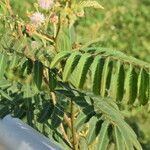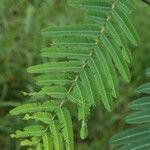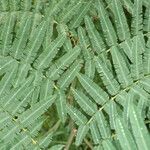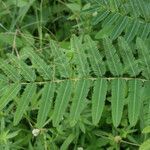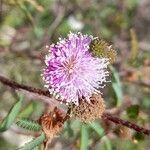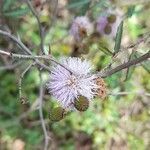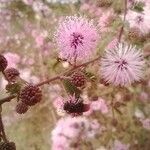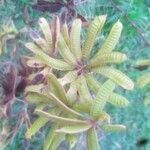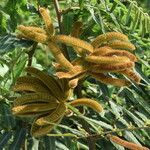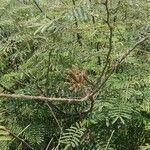Shrub to 3 m high, sometimes scandent or rambling; stems armed with broad-based prickles up to 7 mm long, also usually appressed-or sometimes spreading-setose. Leaves sensitive; petioles, rhachides and rhachillae usually setulose: petiole 0.3-1.4 cm long; rhachis 2-12 cm long, with a straight, erect or forward-pointing, slender prickle up to 1 cm long at the junction of each of the (2)4-14 pairs of pinnae, often with other stouter, spreading or deflexed prickles between the pinnae pairs; rhachillae 1.8-3.6 cm long; leaflets in 18-33 pairs, 3-9 x 0.5 1.25 mm, linear-oblong, ± appressed-pubescent, particularly on the lower surface, margins often setulose, venation nearly parallel to the midrib. Stipules up to 5 mm long, often persistent. Flowers pink or mauve, in subglobose pedunculate heads ±1 cm in diameter, 1-2 in the axils of the upper leaves; peduncles 1-3 cm long, setulose. Calyx minute, 0.75-1 mm long, laciniate. Corolla tubular-campanulate, 2-3 mm long, lobes usually densely pubescent or minutely setulose apically. Stamens 8, free, up to 6 mm long; anthers eglandular apically. Ovary sessile, up to 2 mm long, densely villous. Pods clustered, brown, compressed, straight or slightly falcate, 2.5-7 x 0.8-1.2 cm, bristly all over, breaking up transversely into segments 3-5 mm long, the margins persisting as an empty frame. Seeds olive-brown, narrowly elliptic, up to 7 x 3.5 mm, smooth.
Scrambling or climbing shrub to c. 4 m high. Stems terete, prickly, especially in the juvenile parts densely covered with appressed setae, shoots often with sparse foliage at the base. Leaves: petiole 0.8(-2.8) cm, rachis 3.5-17(-18) cm, slightly angular, densely hispid, with two straight spines, 0.3-1.1 cm at the junction of the pinnae; pinnae 6-14(-16) pairs, evenly distributed along the rachis, c. 3.5-4.5 cm, hispid; leaflets 20-45 pairs per pinna, linear-oblong, with hispid margins, 5.5-8.5 by 0.8-1.1 cm, sharply acute. Inflorescences consisting of pedunculate glomerules, solitary or paired in the upper leaf-axils, peduncles c. 2 cm long, hispid. Flowers sessile, bisexual, tetra-merous. Calyx scarious, tubular at the base, densely laciniate in the distal portion, 1 mm. Corolla funnel-shaped, 3 mm, tube glabrous; lobes ovate-elliptic, acute, c. 1.2 mm, glabrous towards the base, hirsute at the apex. Stamens 8, filaments pink. Ovary 1.5 mm, densely velutinous. Pods clustered, straight, linear-oblong, c. 6 by 1 cm, beaked, densely scabrous; segments 2-3 mm. Seeds grey-brown, oblong, biconvex, 5-5.5 by 2.5 mm.
Shrub 0.6–3(–4.5) m. high, sometimes scandent or rambling.. Stems armed with broad-based prickles up to 7 mm. long, also usually ± appressed-setose.. Leaves sensitive; petiole 0.3–1.5 cm. long; rhachis 3.5–12(–18) cm. long, with a straight ± erect or forward-pointing slender prickle (sometimes short) at the junction of each of the 6–14(–16) pairs of pinnae, sometimes with other stouter spreading or deflexed prickles between the pairs; leaflets 20–42 pairs, linear-oblong, 3–8(–12.5) mm. long, 0.5-l.25(–2) mm. wide; venation nearly parallel with midrib, margins often setulose.. Flowers mauve or pink, in subglobose pedunculate heads about 1 cm. in diameter, 1–2(–3) together in upper axils.. Calyx minute, laciniate, 0.75–1 mm. long.. Corolla about 2.25–3 mm. long.. Stamens 8.. Pods clustered, brown, densely bristly all over, 3–8 cm. long, 0.9–1.4 cm. wide, breaking up transversely into segments 3–4 mm. long, the sutures persisting as an empty frame.. Fig. 13, p. 44.
Shrub to 5 m tall; branchlets terete, appressed-setose, often with broadly based, recurved prickles to 12 mm long. Leaves: axes to 31 cm long, appressed-setulose with scattered or paired prickles to 10 mm long between pinnae pairs and one slender prickle at each pair. Pinnae 12–15-jugate; leaflets 20–45-jugate, to 8.5 mm long, c. 1 mm wide, linear, setulose at the margins. Inflorescences 1–3 per axil or in terminal pseudoracemes; peduncles to 70 mm long, appressed setulose; heads pink, subglobose to oblong, to 10 mm diam. or to 14 mm long. Flowers 4-merous, diplostemonous. Pod flat, linear, to 12 cm long, 9–14 mm wide, straight to slightly curved, densely setose on margins, sparingly long-setose on faces. Seeds ±oblong, 4.5–6 mm long, olivaceous.
Perennial shrub; stems with bristly hairs, often scandent and armed with broad-based prickles, up to 7 mm long. Leaves bipinnate, sensitive to touch, rachis 20-120 mm long, with straight, erect or forward-pointing, slender prickles up to 10 mm long at junction between pinnae. Pinnae in (2)4-14 pairs, often with stouter prickles in between. Leaflets in 8-33 pairs, linear-oblong. Stipules often persistent, up to 5 mm long. Flowers pink in subglobose, pedunculate heads. Flowering time all year. Pod clustered, brown, compressed, straight to slightly falcate, bristly all over, breaking up transversely into segments and margins persisting as an empty frame.
A small shrub. It can be 6 m tall. The stems are green but become woody later. There are broad prickles 7 mm long. The leaves are bright green and twice divided. The central stalk is 20-25 cm long and has prickles. There are 16 pairs of pinnae 5 cm long and each has pairs of leaflets 3-8 mm long. The leaves fold up when touched and at night. The flowers are red or pink and in tight heads 1 cm across. These contain about 100 flowers. Each head produces 10-20 seed pods. These break into segments when ripe. Each section contains one seed. The seeds are light brown or green.
Leaves sensitive; petiole 0·3-1·5(1·8) cm. long; rhachis 3·5-12(18) cm. long, with a straight, ± erect or forward-pointing, slender prickle (sometimes short) at the junction of each of the 6-14(21) pairs of pinnae, sometimes with other stouter, spreading or deflexed prickles between the pairs; leaflets 15-42 pairs, 3-8(12·5) x 0·5-1·25(2) mm., linear-oblong, ± appressed-pubescent, particularly on the lower surface; venation nearly parallel with the midrib, margins often setulose.
Shrub, up to 3 m high, sometimes scandent or rambling. Leaves with straight, erect or forward pointing, slender prickle at junction of each pinna pair; pinnae in 4-14 pairs. Pods clustered, bristly all over, breaking up transversely into segments 3-5 mm long, margins persisting as an empty frame. Flowers in heads; pink, mauve.
Shrub 0·6-3(4·5) m. high, sometimes scandent or rambling; stems armed with broad-based prickles up to 7 mm. long, also usually ± appressed-or sometimes spreading-setose.
Pods clustered, brown, 3-8·5 x 0·9-1·4 cm., bristly all over, breaking up transversely into segments 3-6 mm. long, the margins persisting as an empty frame.
Flowers mauve or pink, in subglobose pedunculate heads c. 1 cm. in diam., 1-2(3) together in the upper axils.
Calyx minute, 0·75-1 mm. long, laciniate.
Corolla c. 2·25-3 mm. long.
Pale mauve flower-balls
Sensitive leaves
A prickly shrub
Stamens 8.
